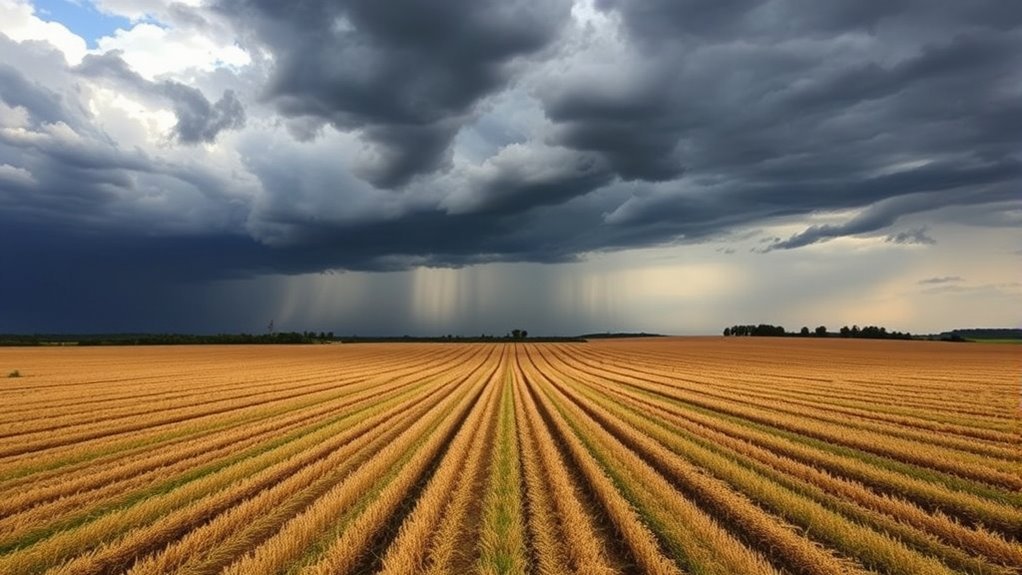Meteorology is vital in studying squalls, as it provides essential understandings into their formation and development. By utilizing real-time meteorological data, forecasters can predict sudden weather changes and hazardous conditions. Factors such as humidity, wind patterns, and atmospheric instability are key to understanding squalls. This knowledge not only aids in accurate forecasting but also helps mitigate their impact on agriculture, transportation, and community safety. Further exploration reveals additional dimensions of squall effects and management strategies.
Main Points
- Meteorology utilizes advanced data collection techniques to monitor atmospheric conditions that lead to squall formation and predict their intensity and path.
- Predictive modeling and numerical weather prediction enhance the accuracy of squall forecasts, improving public safety and preparedness.
- Real-time observations from radar and satellite imagery allow meteorologists to track squalls and issue timely warnings for affected areas.
- Understanding the impacts of squalls on agriculture and infrastructure helps identify risks and develop mitigation strategies for communities.
- Collaboration among meteorological agencies, emergency services, and local authorities ensures effective communication and coordinated responses during squall events.
Understanding Squalls: Definition and Characteristics
Squalls are sudden, intense bursts of wind that can be accompanied by rain or other forms of precipitation, often leading to dramatic changes in weather conditions. They typically arise from rapidly developing atmospheric disturbances, such as cold fronts or thunderstorms.
Squalls can vary in duration, intensity, and the type of precipitation they produce, ranging from brief gusts to prolonged periods of adverse weather. The wind speeds associated with squalls can exceed 30 knots, creating hazardous conditions for maritime navigation and outdoor activities.
Additionally, squalls are distinguished by a sharp temperature drop and a noticeable shift in wind direction, which can catch those unprepared off guard. Their unpredictability makes squalls particularly concerning for meteorologists and those who rely on accurate weather forecasts.
Understanding the definition and attributes of squalls is essential for anticipating their impacts and mitigating potential risks.
The Importance of Meteorological Data in Squall Prediction

Meteorological data plays a vital role in predicting squalls, as it enables the collection of real-time observations essential for accurate forecasting.
Various data collection techniques, such as satellite imagery and ground-based sensors, provide significant perspectives into atmospheric conditions.
Additionally, predictive modeling strategies utilize this data to improve the reliability of squall forecasts, finally aiding in preparedness and response efforts.
Data Collection Techniques
Accurate prediction of squalls relies heavily on robust meteorological data collection techniques. Various methods are employed to gather essential information, including satellite observations, weather radar, and surface weather stations.
Satellite imagery provides a broad view of atmospheric conditions, allowing meteorologists to monitor cloud formation and movement. Weather radar is vital for detecting precipitation patterns, wind shifts, and storm intensity, while surface weather stations contribute real-time data on temperature, humidity, and barometric pressure.
Additionally, remote sensing technologies and balloon-borne instruments improve data collection at different altitudes. These techniques collectively enable meteorologists to analyze the environmental parameters that influence squall formation, thereby improving the accuracy of forecasts and enhancing safety measures for affected regions.
Predictive Modeling Strategies
Effective predictive modeling strategies are essential for improving squall prediction accuracy. These strategies utilize extensive meteorological data to forecast squall events, thereby aiding in preparedness and response.
Through a combination of advanced techniques, meteorologists can better understand squall dynamics. Key components of effective predictive modeling include:
- Data Assimilation: Integrating real-time observations with numerical models to improve forecasts.
- Statistical Analysis: Utilizing historical data to identify patterns and correlations associated with squall occurrences.
- Machine Learning Algorithms: Implementing AI-driven methods to boost predictive capabilities based on large datasets.
- Ensemble Forecasting: Running multiple simulations to assess uncertainty and improve reliability in predictions.
Atmospheric Conditions Leading to Squall Formation
While various atmospheric conditions contribute to the formation of squalls, the interplay of temperature, humidity, and wind patterns plays an essential role. Typically, squalls develop when warm, moist air rises rapidly, often colliding with cooler, denser air. This collision can create instability within the atmosphere, leading to the rapid development of thunderstorms. High humidity levels are important, as they provide the moisture necessary for cloud formation and precipitation.
Additionally, wind patterns greatly influence squall development; strong winds at different altitudes can create shear, enhancing the upward motion of air. This dynamic interaction can lead to the formation of severe weather systems, defined by intense rainfall, gusty winds, and sudden temperature drops.
Understanding these atmospheric conditions is critical for meteorologists, as it informs predictions and warnings related to squall events, ultimately aiding in public safety and preparedness.
Advanced Forecasting Techniques for Squalls

As meteorologists aim to improve their forecasting capabilities, advanced techniques have emerged to predict squalls more accurately. These methods utilize state-of-the-art technology and sophisticated models to boost the reliability of squall predictions.
- Numerical Weather Prediction (NWP): Utilizing complex mathematical models to simulate atmospheric conditions, NWP has greatly improved squall forecasting precision.
- Radar Technology: Advanced Doppler radar systems provide real-time data on wind patterns and precipitation, aiding in immediate squall detection.
- Machine Learning Algorithms: By analyzing extensive datasets, machine learning identifies patterns and trends that traditional methods may overlook, refining forecast accuracy.
- Satellite Imagery: High-resolution satellite images contribute significant information regarding cloud formation and movement, essential for predicting squall onset.
These sophisticated techniques allow meteorologists to provide timely warnings, thereby reducing risks associated with squalls and improving public safety.
The Impact of Squalls on Agriculture and Food Security

Squalls can significantly disrupt agricultural activities and threaten food security. These sudden, intense weather events can lead to crop damage due to strong winds and heavy precipitation, which may uproot plants or cause soil erosion.
Farmers often face challenges in managing waterlogged fields, resulting in delayed planting and harvesting schedules. Additionally, squalls can hinder the pollination process, negatively impacting yields.
Livestock also suffers during squalls, as adverse conditions can lead to increased stress and susceptibility to illness. This can further strain food supply chains, particularly in regions reliant on local agriculture.
The unpredictability of squalls complicates planning for farmers, forcing them to invest in mitigation strategies that may not always be effective.
Squalls and Their Effects on Transportation and Aviation
Unpredictability in weather patterns poses considerable challenges for transportation and aviation, particularly during squalls. These sudden and intense weather events can obstruct operations, leading to safety concerns and economic losses. The effects of squalls are complex, impacting various aspects of both sectors.
- Flight Delays: Squalls can lead to notable delays as pilots maneuver changing conditions, which may require rerouting or holding patterns.
- Road Hazards: Intense winds and sudden precipitation can create treacherous conditions for drivers, increasing the risk of accidents.
- Visibility Issues: Reduced visibility during squalls complicates landing and takeoff for aircraft, necessitating alternate procedures.
- Infrastructure Stress: Transportation infrastructure, including runways and roads, may suffer damage from high winds and heavy rain, leading to costly repairs.
Meteorological information into squalls is essential for minimizing their obstructive impacts on transportation and aviation.
Building Resilience: Community Preparedness for Squalls
Effective community preparedness is essential in mitigating the impacts of squalls, especially given the challenges they pose to transportation and aviation. Communities must develop thorough response plans that include timely weather alerts and designated safety protocols.
Training sessions and informational workshops can improve public awareness, equipping residents with the knowledge to respond effectively during squall events.
Collaboration among local authorities, meteorological agencies, and emergency services is critical. This cooperation guarantees that accurate forecasts are disseminated promptly and that communities can mobilize resources, such as shelters and medical aid, as needed.
Infrastructure improvements, like drainage systems and road maintenance, also play an important role in reducing vulnerability to squall-related damage.
Furthermore, community drills can promote a culture of preparedness, allowing individuals to practice and refine their response strategies.
Through these proactive measures, communities can build resilience against the unpredictable nature of squalls, ultimately safeguarding lives and property.
Common Questions
How Do Squalls Differ From Regular Thunderstorms?
Squalls are defined by sudden, intense winds and brief heavy precipitation, differing from regular thunderstorms, which typically feature prolonged rain and less extreme wind. Squalls can occur unexpectedly, often leading to hazardous conditions.
What Are the Historical Records of Squall Events?
Historical records of squall events reveal varying intensities and occurrences, often documented through ship logs and weather journals. These records underscore the significance of squalls in maritime navigation and regional weather patterns across different time periods.
Can Squalls Affect Wildlife and Ecosystems?
Squalls can considerably impact wildlife and ecosystems, causing disturbances in habitats, altering food availability, and affecting breeding patterns. These sudden weather events may lead to increased mortality rates among vulnerable species and disrupt ecological balance.
How Do Squalls Impact Power Supply and Infrastructure?
Squalls considerably impact power supply and infrastructure by causing power outages and damaging electrical lines. High winds and heavy precipitation can lead to fallen trees and debris, disrupting transportation and communication networks essential for community functioning.
What Personal Safety Measures Should Be Taken During a Squall?
During a squall, individuals should seek shelter indoors, avoid windows, secure outdoor objects, and stay informed through weather updates. Wearing sturdy footwear and having emergency supplies prepared can improve personal safety during such severe weather events.

